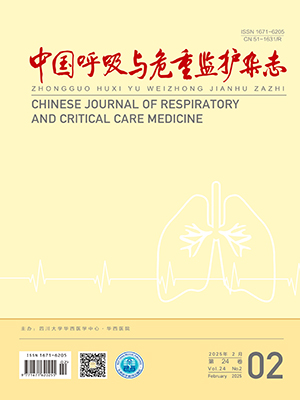| 1. |
Lin J, Wang W, Chen P, et al. Prevalence and risk factors of asthma in mainland China: The CARE study. Respir Med, 2018, 137: 48-54.
|
| 2. |
史宏磊, 黄克武. 支气管哮喘诊治年度进展2023. 中华结核和呼吸杂志, 2024, 47(2): 157-162.
|
| 3. |
Global Initiative for Asthma[EB/OL]//Global Initiative for Asthma - GINA. [2024-05-07]. https://ginasthma.org/.
|
| 4. |
Côté A, Godbout K, Boulet L P. The management of severe asthma in 2020. Biochem Pharmacol, 2020, 179: 114112.
|
| 5. |
张韩伟, 蒋毅, 张亚丽, 等. 重度哮喘临床特征、炎症标志物特点及危险因素分析. 中国呼吸与危重监护杂志, 2023, 22(9): 609-614.
|
| 6. |
Wang W, Wang J, Song G, et al. Environmental and sensitization variations among asthma and/or rhinitis patients between 2008 and 2018 in China. Clin Transl Allergy, 2022, 12(2): e12116.
|
| 7. |
李宛珈, 黄志锋, 朱惠清, 等. 猫狗马动物皮屑相关的过敏性疾病流行病学调查研究. 中华预防医学杂志, 2022, 56(9): 1279-1288.
|
| 8. |
Morris DO. Human allergy to environmental pet danders: a public health perspective. Vet Dermatol, 2010, 21(5): 441-449.
|
| 9. |
Weiss ST. Eat dirt-the hygiene hypothesis and allergic diseases. N Engl J Med, 2002, 347(12): 930-931.
|
| 10. |
Trifonova D, Curin M, Riabova K, et al. Allergenic activity of individual cat allergen molecules. Int J Mol Sci, 2023, 24(23): 16729.
|
| 11. |
Melén E, Wickman M, Nordvall SL, et al. Influence of early and current environmental exposure factors on sensitization and outcome of asthma in pre-school children. Allergy, 2001, 56(7): 646-652.
|
| 12. |
Esty B, Permaul P, DeLoreto K, et al. Asthma and Allergies in the School Environment. Clin Rev Allergy Immunol, 2019, 57(3): 415-426.
|
| 13. |
Perzanowski MS, Ronmark E, James HR, et al. Relevance of specific IgE antibody titer to the prevalence, severity, and persistence of asthma among 19-year-olds in northern Sweden. J Allergy Clin Immunol, 2016, 138(6): 1582-1590.
|
| 14. |
Chan-Yeung M, McClean PA, Sandell PR, et al. Sensitization to cat without direct exposure to cats. Clin Exp Allergy, 1999, 29(6): 762-765.
|
| 15. |
Arbes SJ Jr, Cohn RD, Yin M, et al. Dog allergen (Can f 1) and cat allergen (Fel d 1) in US homes: results from the National Survey of Lead and Allergens in Housing. J Allergy Clin Immunol, 2004, 114(1): 111-117.
|
| 16. |
Platts-Mills TA, Vaughan JW, Carter MC, et al. The role of intervention in established allergy: avoidance of indoor allergens in the treatment of chronic allergic disease. J Allergy Clin Immunol, 2000, 106(5): 787-804.
|
| 17. |
Woodfolk JA. T-cell responses to allergens. J Allergy Clin Immunol, 2007, 119(2): 280-294.
|
| 18. |
Shamji MH, Durham SR. Mechanisms of allergen immunotherapy for inhaled allergens and predictive biomarkers. J Allergy Clin Immunol, 2017, 140(6): 1485-1498.
|
| 19. |
Satyaraj E, Gardner C, Filipi I, et al. Reduction of active Fel d1 from cats using an antiFel d1 egg IgY antibody. Immun Inflamm Dis, 2019, 7(2): 68-73.
|
| 20. |
Shamji MH, Singh I, Layhadi JA, et al. Passive prophylactic administration with a single dose of anti-Fel d 1 monoclonal antibodies REGN1908-1909 in cat allergen-induced allergic rhinitis: a randomized, double-blind, placebo-controlled clinical trial. Am J Respir Crit Care Med, 2021, 204(1): 23-33.
|
| 21. |
Braun-Fahrländer C, Riedler J, Herz U, et al. Environmental exposure to endotoxin and its relation to asthma in school-age children. N Engl J Med, 2002, 347(12): 869-877.
|
| 22. |
Liu AH. Endotoxin exposure in allergy and asthma: reconciling a paradox. J Allergy Clin Immunol, 2002, 109(3): 379-392.
|




